The Minolta TC-1 always struck me as an odd looking little camera with a few feature and design choices that just didn’t sit well with me. But over that last 6 months – give or take – it’s turned from being a camera that I didn’t understand to one that I felt might fit my requirements for a compact camera more than anything else available.
The idea of something different first reared its head whilst I was having all the problems with my GR1v. It just crossed my mind a few times that it might be worth giving up and trying something different. Yet for all the problems I’ve had with the GR1v, it still sits upon quite a high pedestal and has been my choice compact for quite a time now. It’s just the first camera I pick up any time I’m going for a trip somewhere when I want something I am 100% comfortable and confident shooting with.
Unfortunately, there are very few options if you want a feature packed 28mm lensed compact camera. I’ve already tried the Klasse W, and though liked it, I didn’t love it. That only left the Nikon 28ti and the Minolta TC-1. I’ve not used a Nikon ti, but from what I’ve read about them, it seems it can feel a little slow in use. This is something I think I can be particularly sensitive to since I found the Klasse so slow; a fact that seems to be contested by others.
So there was only the TC-1 left, a camera that – as I say – didn’t seem to sit well with me feature wise. In fact it almost sounds a little odd on paper, certainly eccentric, and looks a bit weird too. I found myself concerned about the slowness of the f/3.5 lens, and definitely unsure about that fiddly looking control around it that operates the aperture. An aperture – I should add – that is fully manual! To clarify, this camera – a little compact camera – has no true fully automatic mode meaning that fiddly looking little aperture control is going to be in constant use. And then on top of this, it has limited aperture options. With only f/3.5, f/5.6, f/8 and f/16, surely there will be situations where this causes frustrating limitations?
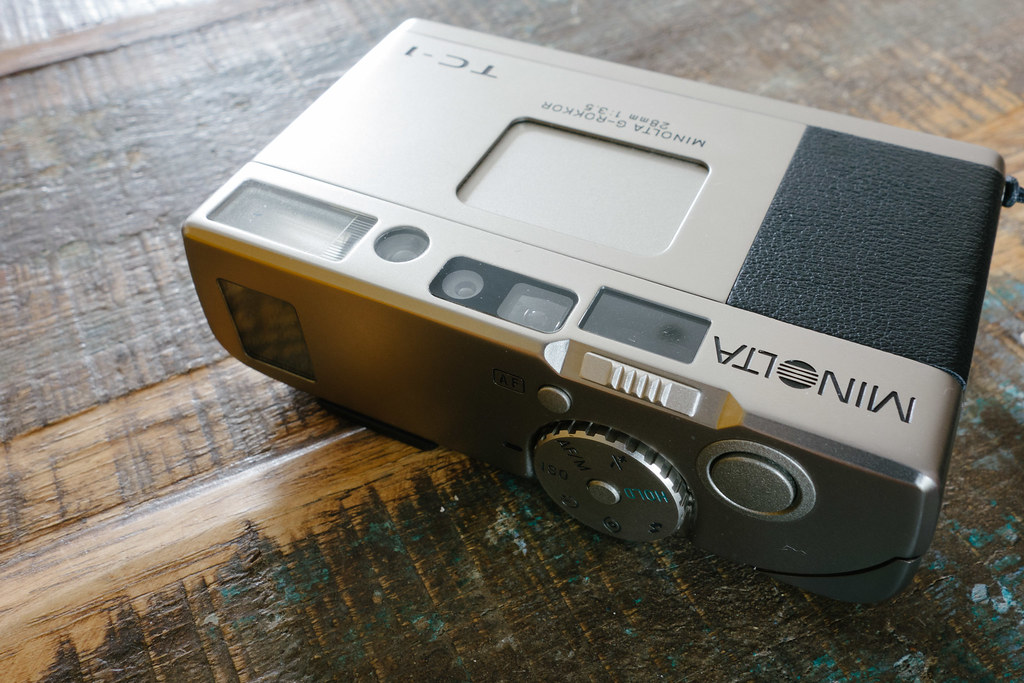
But then contrary to all this, if you read the relatively sparse info that’s out there online about this camera, it’s very hard to find a bad word said about it; at least by anyone who has actually owned one. In fact relatively speaking I think found more “best compact ever made” comments than I have about any other camera.
Around about the same time as the problems with the GR1v were happening I had also been thinking a lot more about this “perfect” combination of kit. This is something that – perhaps a little unnecessarily – I obsess about. I’ve mentioned a few times on this blog that the Leica M7 is a camera that feels fairly central to the concept of perfection in gear for me. Combined with the Ricoh GR1v for eg, the M7 provides the longer/faster lens options, whilst the Ricoh provides the wide angle, AF, flash, and a much more happy snappy approach. But the Ricoh left that funny taste in my mouth, the trust just isn’t there anymore.
So clearly I had talked myself into a Minolta TC-1. Learning from the mistake I made with the Ricoh, I dropped Bellamy an email. A few emails back and forth and a few cameras looked at, eventually he found one that was boxed, as new and in my budget! A rather painful week of waiting (I hate waiting for the postman) and I had my lovely looking, like new camera in my hand. Or at least it looked like new…
Unfortunately a couple of rolls into shooting the Minolta it became clear that all was not well. I little blob/smear of something that looked like a light leak was beginning to prove consistent. I emailed Bellamy, and yes, he confirmed he had seen it before, and it was indeed a light leak. Thankfully – for me at least – this time I had made the sensible decision to buy it from a dealer.
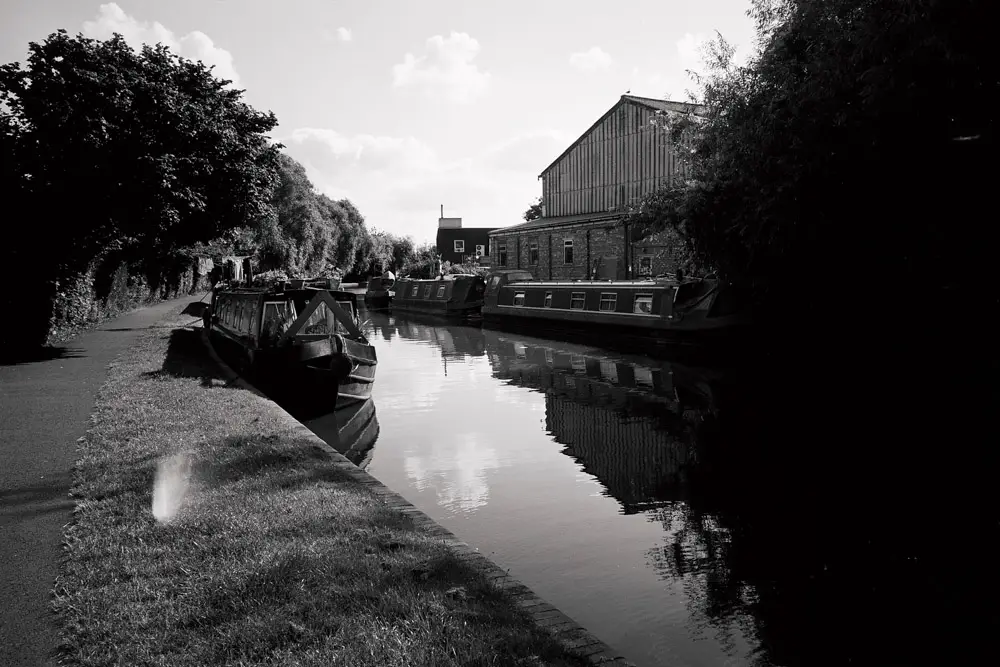
So, back it went to Japan for a visit to Konica Minolta for repair – yes, they’re still repairing them! So all that out of the way, I now have it back, it’s working, it’s clean as a whistle, and I have a camera that has been serviced by the manufacturer themselves i.e. I have 100% confidence in its working condition … But is it actually any good?
The Minolta TC-1 – My review
The first thing instantly that struck me about the Minolta TC-1 was its size. It’s truly tiny, aps camera tiny, “shirt-pocket” tiny, and that’s normal shirt pockets, not those odd 3’x2′ shirt pockets a lot of photographers seem to have. The second thing that’s immediately apparent when you pick it up is the build quality. It’s nearly up there with the Contax T2 in terms of how solid it feels, though it feels a bit more refined. It doesn’t feel like you could defend your self in battle with it in the way the Contax does, but what it lacks in meat, it makes up for in the sense of quality it gives you. The outer shell, including all the controls and even battery cover seem to be made from titanium. It certainly feels like more of a camera than the very light weight, almost flimsy feeling Ricoh. Yet with Ricoh in one hand and Minolta in the other, there is little discernible difference in weight. There is aways going to be a negative when it comes to cameras being very small and it usually manifests itself in their handling. The Ricoh GR range being the obvious exception; a camera that – when it comes to handling – is actually one of the best designed cameras ever made in my opinion. The TC-1 doesn’t quite handle as nicely, it clearly doesn’t have the same size or comfortably shaped grip as the Ricoh, but despite being smaller it holds better than the likes of the Contax T2 for my tastes.

The danger with small compacts is always the stray finger issue. The one where because of some slight design flaw or personal incompatibility, when you hold the camera in the most natural feeling way, you find your finger in front of the lens, or indeed interacting with the barrel of the lens. I find this to be caused by a lens that’s too far to the grip side of the camera, combined with a shutter button that’s too far along the top of the camera. You are forced to hold the camera with a bit too much hand. It’s a combo that both Contax T2 and Yashica T4/5 suffer from in my opinion. The Minolta TC-1 is an interesting case, as really you need a finger to be able interact with the lens to control the aperture, but then when shooting, don’t want that finger in the way. Despite its near lilliputian dimensions, it actually manages to achieve this quite well. My middle finger grips the cameras patch of grippy leather/faux leather material, whilst my index finger can alternate between adjusting the aperture and the using the shutter button quite comfortably.
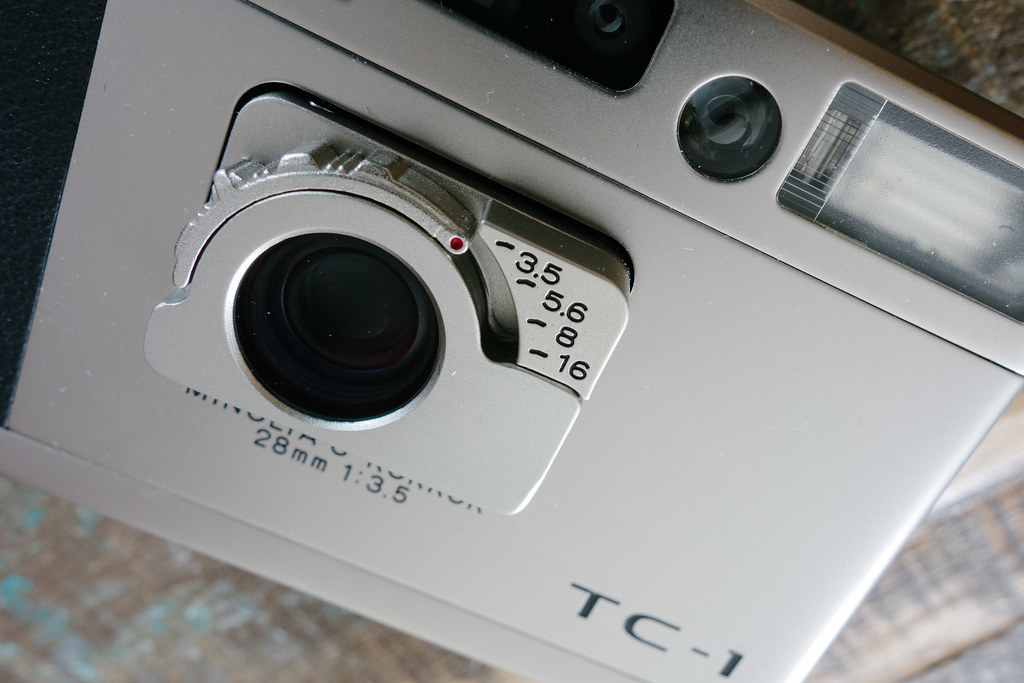
Controlling the camera and its features
Since I’m talking about the aperture control, I might as well mention that my concerns about how fiddly it would be to use were mostly ill founded. As I mentioned previously, it’s made out of titanium, and has a very positive finger grip on it. To say it’s not fiddly at all would be an exaggeration, but I have to acknowledge the achievement of it being both very small, and very usable. In fact, most of the cameras controls and features belie its size in the usability stakes to some degree.
The control dial is big, solid and clicks satisfyingly through its setting points with a lock on “hold” to prevent settings from being changed accidentally. Once the dial is set to the function you wish to change the settings are altered with the forefinger-controlled slider switch on the top/front edge of the camera. Once settings are chosen, they stay set regardless of whether or not the camera is turned off between uses. You can set the camera to work how you want it to work and it will stay that way until you choose to change the settings. Even the order of the settings on the dial is well thought out with the more regularly required adjustments closer to the “hold” locking point.
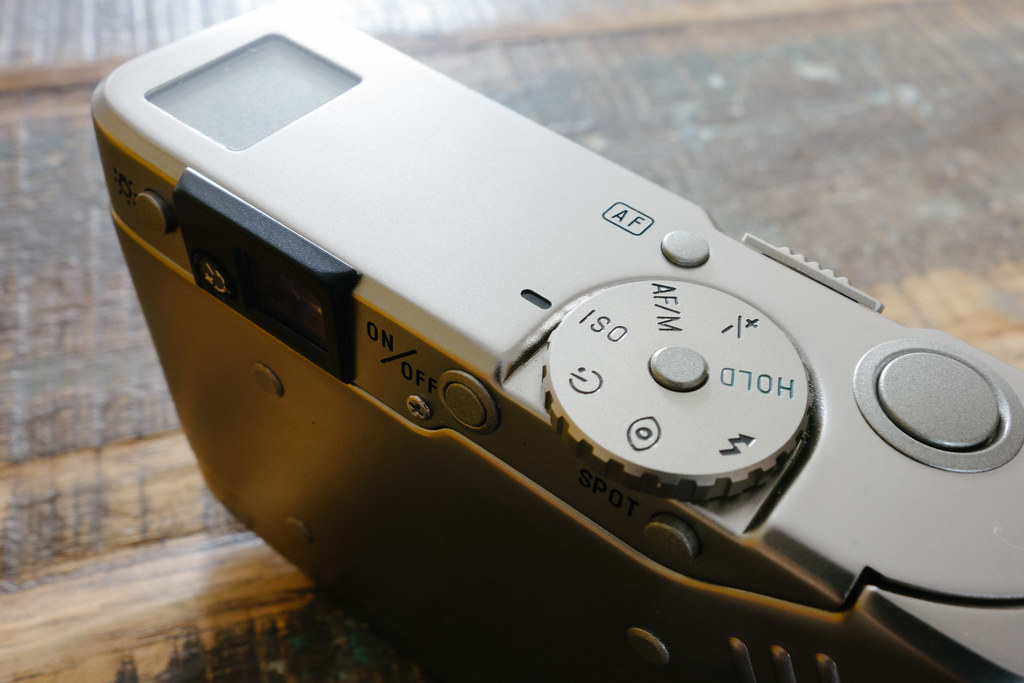
Exposure compensation
-/+ 4ev through 1/2ev steps. I’m not sure I’ve ever used more than 2 stops of exposure compensation, but I’m not going to complain. Combined with the spot meter this range of exposure compensation could be very useful if you are into using the zone system I suppose.
AF/M
Switches the camera between autofocus and a large range of manual focus distances. Like the Fuji Klasse, it’s not a particularly practical option for shot-by-shot manual focusing, but is ok for pre/zone focusing and is a little less fiddly than the Klasse to set. Focusing can also be reset to AF quickly by pushing the “AF” button on top of the camera. If you’re sometimes an “f/8 and be there” kind of person, it’s quite possible with this camera. Set the manual focus to 5m the lens to f/8 and away you go. Because all settings are retained, you can set the camera up like that for a day of happy snapping and not have to think twice; it’s just that initial setting of the focus that is a bit of a faff. What would have made it more useable is if the AF reset button could also be used to switch back to MF. Or maybe just a separate AF/MF switch would have worked. One way or another, it’s nice that it’s there, impressive considering the cameras size, but it’s not the perfect implementation of the feature in my opinion.
ISO & Self timer
Manual ISO override is always useful, especially when like the Minolta TC-1 it ranges from 6 to 6400iso. The self timer offers 2 and 10 second options and does what it says on the tin.
Flash modes
The TC-1 has various flash modes which like all other modes stick when set even if the camera is turned on and off. They are though a little more confusing after you read the manual. On the surface of it options are simple; off, on, night-portrait and red-eye reduction, which – thanks to it being controlled with a separate setting – can be selected with either or neither of the flash-on modes. What seems a little confusing is that the manual seems to state that for night portrait mode to work, not only do you have to set it night portrait mode but you have to press both the spot meter button and shutter button at the same time for it to operate. This isn’t true, night portrait – or first curtain slow sync to be a little more precise – works regardless of whether or not you press the spot meter. What is actually the case is that if the flash is on, but not in night portrait mode, pressing the spot meter button will activate the night portrait mode for a single exposure.
Referring back to the manual, there is one line where it refers to the “night portrait” mode as “fill-in/night portrait”. In short, what I think the manual is trying to say is this: If you wish to fill-flash your subject in normal or back-lit daytime scenes use the spot meter to meter your subject with the flash switched on. Doing so will balance the ambient light to the light of the flash. Conversely, the dedicated night portrait mode is there for balancing ambient light to flash in specifically low lit scenes… At least that’s what I make of it all.
Further to this confusion there are some other considerations that make using the flash not quite as simple a procedure as it could be. Firstly, since there is no automatic aperture control, the usual “flashmatic” style of the camera controlling the flash is off the cards. In fact, the flash can only be shot at f/3.5; shooting at anything less will apparently cause underexposure. Additionally to this it seems that if you wish to compensate the flash accurately you need to use the manual ISO override.
To be honest, I’m not a big user of flash. And when I do use it, it’s usually of friends of family in resultant or pubs etc. and for that purpose I’ve found it works just fine.

The viewfinder
Excellent! At least once it finds your eye it is. It does have a very narrow angle with which it needs to be looked through, meaning it blacks out quite easily. But look through it right and it’s big and bright and filled with useful information. There is a focus confirmation light and a distance indicator to indicate the distance focused and a flash ready light. There is also a shutter speed indicator, though this is more of a guide than anything else:
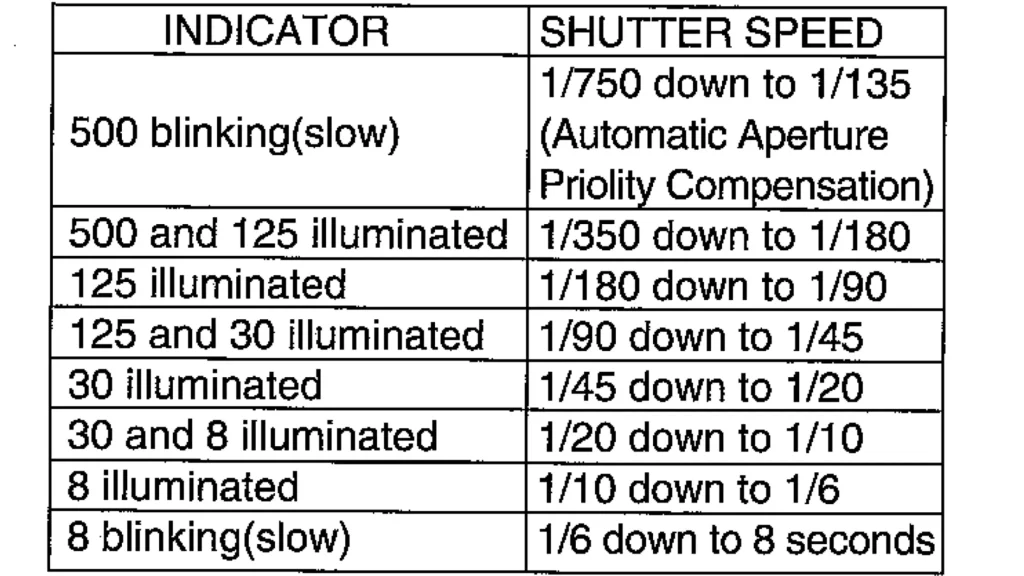
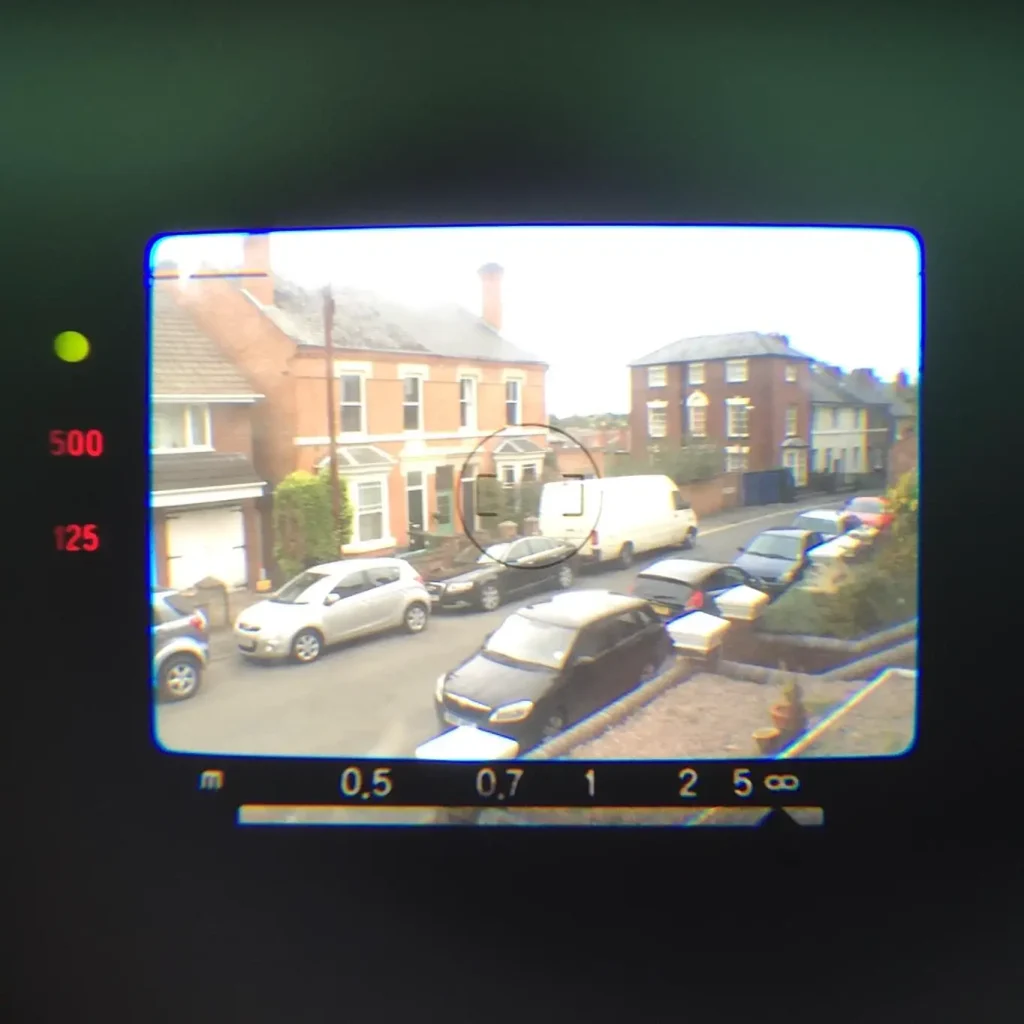
Just next to the viewfinder is a diopter adjustment dial set into the viewfinder surround. Both dial and surround are made of plastic, an odd choice I think considering the rest of the camera is made of metal.
Top screen
The shutter speed info in the viewfinder is also backed up by the screen on the top giving an exact reading should you need it. This screen also gives details of all modes as set and is lit with a nice easy-to-find screen illumination button.
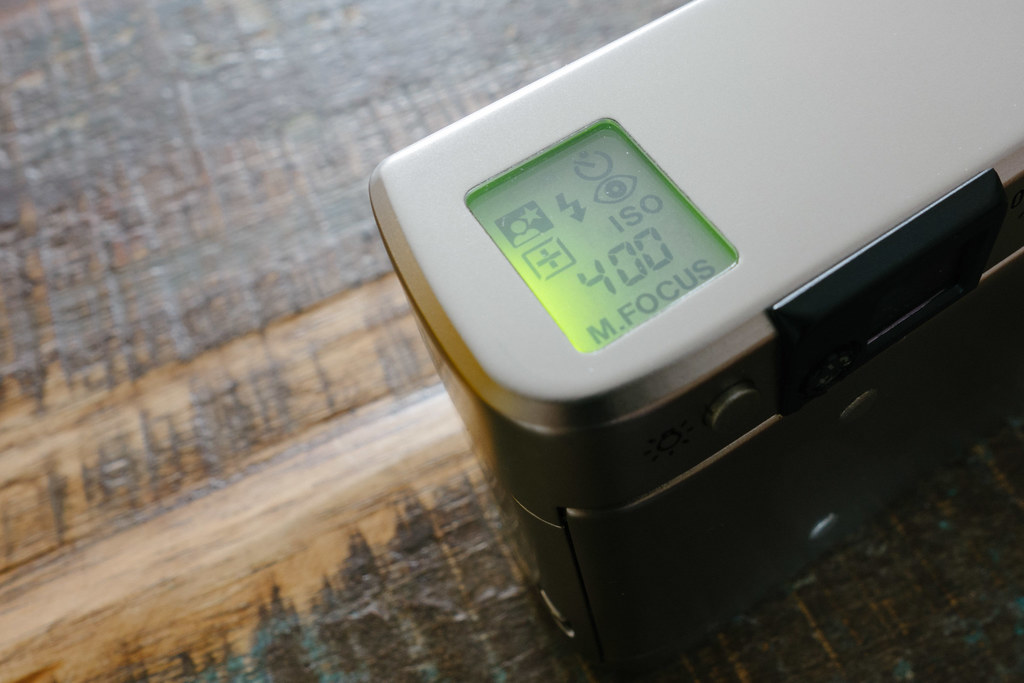
The Minolta TC-1 metering system
If you have read my Contax T2 and Leica M7 reviews you will understand that I favour metering systems that work in a fairly specific way, or at very least allow me to meter in a way I am most comfortable with should I feel the need. Happily, the Minolta TC-1 affords me that pleasure.
The Minolta’s metering system is described in the manual as a “2 segment centre weighted/spot meter”. In short, it gives the user two options for metering a scene. There is a “2 segment” centre weighted meter and a spot meter; the centre weighted being the default behaviour. I’ve no idea how the “2 segment” meter works beyond that it is using a combined reading of 2 segments to give a result. In practice though it’s pretty good for general point & poke shooting. That said, I do find its behaviour a little odd as I’m not sure “centre weighted” is really an entirely accurate description for how it works. I actually asked on rangefinder forum about my findings to see if anyone else’s TC-1 acts the same as mine. I initially thought it might be playing up, but no, it works the same as someone else’s so I’m going to assume it is normal behaviour.
When looking through the viewfinder there is a circular marking, within this circle is where the camera takes it’s spot reading from (more on that in a mo). I have also found this circle to be the rough inside edge of a doughnut shaped metering pattern i.e. if there is a point of light dead centre, the meter doesn’t seem as sensitive to it as if the same point of light is just outside the circle. Conversely of course, when spot metering, it is the dead centre of the circle that is most sensitive to the light. The same can be said for the opposite lighting situation i.e. If there is an area of shade inside the circle that area of shade isn’t accounted for to the same degree as if it is just outside the circle. In practice of course this doesn’t have huge ramifications as if it the area you wish to meter from is the size of the centre spot, you’ll probably choose the spot meter anyway. It’s just worth being aware of I think as I feel that it caught me out on my first roll when taking this shot:
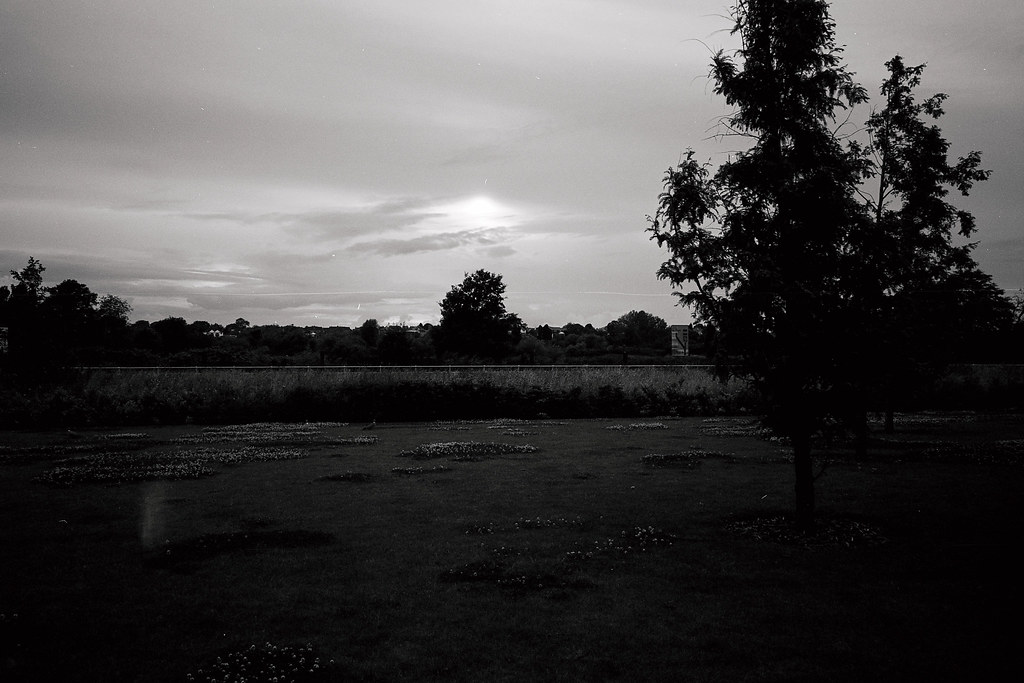
With the setting sun in this doughnut area, the outcome is largely underexposed. Of course this scene might have caused problems for many cameras, and using the spot to meter to take a reading from somewhere in the foreground would probably have been a safer bet for a scene like this regardless of the metering system. One way or another though this photo does seem to demonstrate the point. A secondary impact of this doughnut shaped pattern is that its weighting spreads closer to the edge of the frame than you might expect from a centre weighted meter.
Additionally to the (not so) centre weighted meter is the spot meter. As mentioned, the spot meter takes its reading from the circle that can be seen through the viewfinder. This spot meter actually has two modes; SP1 and SP2. Whilst the camera is switched on pressing and holding the power button and the spot meter button brings up a menu controlled by the menu lever. As received, my camera was set to SP2, so that is where I will start.
SP2 is probably the less fiddly of the two modes, it allows a single click of the spot meter to lock a reading for shooting i.e. point the camera at the area you wish to meter from, single click the spot meter and assuming you are happy with the reading, reframe and shoot. If you are unhappy with the reading a second click of the button switches the spot meter off, allowing you to click it again whilst pointing at a different area of the frame to lock in a different reading. If like me you like taking a few readings from around a frame, this mode does mean a lot of clicking of the button switching the meter on and off as you asses the frame. The advantage of it is that once you have the reading, you can concentrate on framing and focusing without having to hold a button. What’s particularly nice is the fact that it doesn’t cancel the meter reading after an attempt at focus, that reading is locked in until after the shot is taken or it is canceled.
SP1 doesn’t lock the reading from a single click, it requires you to point at the desired zone for a reading, click, hold the spot meter button, reframe and shot. This mode allows for possibly slightly faster readings and shooting, I’m just not a fan of having to hold my finger on the button to lock the reading. To be honest the difference between the modes is negligible, and either way it works for taking a nice accurate reading and allows a very elegant way to separate what you focus and take your meter reading from. One thing I feel the camera lacks though is the meter constantly updating itself like the Contax T2 does. Combining the constantly updating meter with the level of function this meter has somehow would really be quite something I think.
Metering range and shutter speed limitations
The TC-1 has a shutter speed range from 4-1/750sec. EV (100iso) 1.5-17. Though the low end is apparently clipped by a stop to EV 2.5 when using the spot meter; no idea why. The high speeds are also helped along at wider apertures by a system Minolta call “Automatic Aperture Priority Compensation”; a system that – by the use of a reduced shutter aperture – limits the light automatically. In short, it allows the use of larger apertures in brighter conditions by using what amounts to a secondary aperture. This secondary aperture isn’t round like the manual ones are though, so – as minolta warn – it might have a negative impact on the out of focus areas… Though I’m not all that convinced by the claims about the round apertures and them having a big effect on bokeh anyway (a point I shall return to later). What this system does do, is allow you to forget to set a smaller aperture in brighter light. As long as the 1/500th indicator in the VF is flashing slowly, and not fast, you know you are going to get a reasonable exposure. A nice – if slightly odd – twist in the tale of this camera I think.
Focusing and Shooting
Focusing isn’t the smoothest ride out there I must admit. It’s not 100% in terms of how frequently it finds focus first time. And sometimes – though not often – it can miss repeatedly. Focusing is also a little noisy, and since it’s a passive AF camera it needs to move the lens each time it attempts to focus. This can lead to the lens extending and retracting a few noisy times before it’s latched onto what you want it to. Its saving grace is the distance indicator in the VF. At least with that there to help, you can reliably know when you have or haven’t focused on what you hoped. To be fair to it, it doesn’t miss that often, just being picky, it misses slightly more than I think it should.
In terms of focus and shutter lag, assuming it finds focus, it finds it quickly, and to my mind there is little of no actual shutter lag. I have in fact been caught out by the shutter button being ever-so-slightly over sensitive. This is something that – despite meaning I might take and accidental photo once in a while – I do actually like; it makes the camera feel eager, and quick of the mark when you are actually ready to shoot.
Lens and photos
The lens is clearly a force to be reckoned with. Contrast and resolution are through the roof, resulting in photos that really pop with detail. I’m not sure I have another 28mm lens of any brand, for any camera that is as subjectively sharp. This sharpness is also pretty consistent both across the frame and throughout the aperture range. To my eye at least, it’s only the very corners that soften/smear ever-so-slightly.
Being a f/3.5 28mm lens, bokeh is rarely a dominant feature in photos, but it does feel like it needs a mention. There seems to be quite a fuss made about this cameras perfectly round aperture stops in relation to its effect on out of focus rendering, but personally I can’t see how they can possibly make that much difference. At f/3.5, wide open, the shape of the aperture is irrelevant to the bokeh anyway, and at f/5.6, 8 or 16 on a 28mm lens it’s not exactly like out of focus spectral highlights are going to reveal themselves as large disks etc in the way they do in a fast/long lens. That all said, the out of focus areas of an image are rendered pleasingly and reasonably smoothly. In-focus points of light are also rendered completely free of the usual star shapes that come along with normal aperture blades, though these stars seem to be replaced with halos:
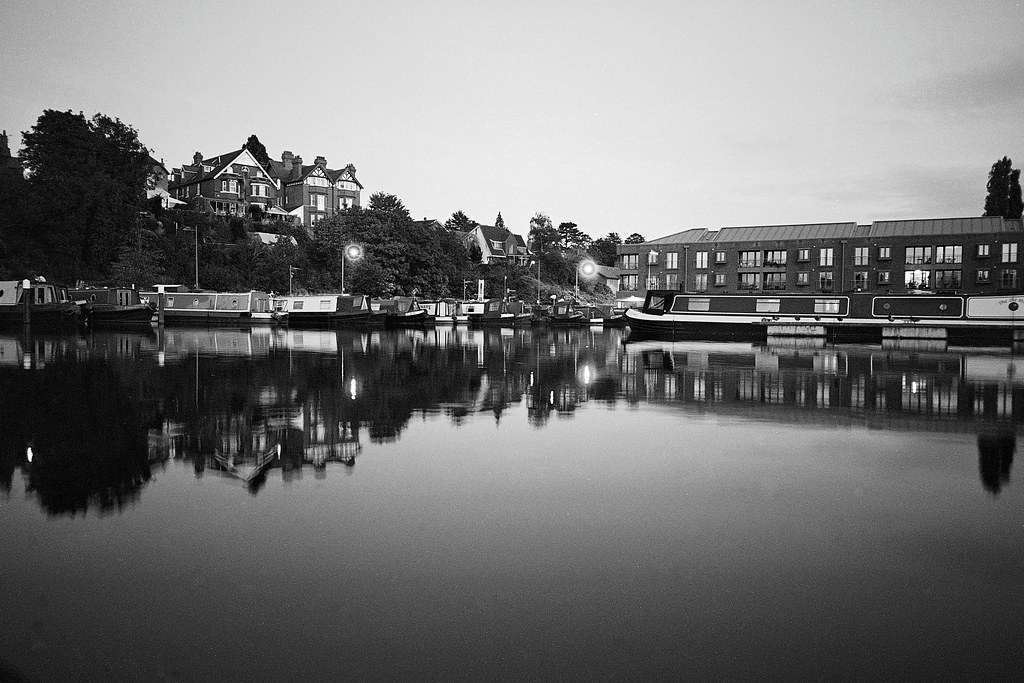
I’ve noticed the tiniest amount of pincushion distortion in a couple of photos, but even shooting architecture I’ve not found it an issue. Flare is also seemingly very well controlled, I’ve not seen any nasties in my photos, not a bit of ghosting, and very little evidence of any veiling flare.
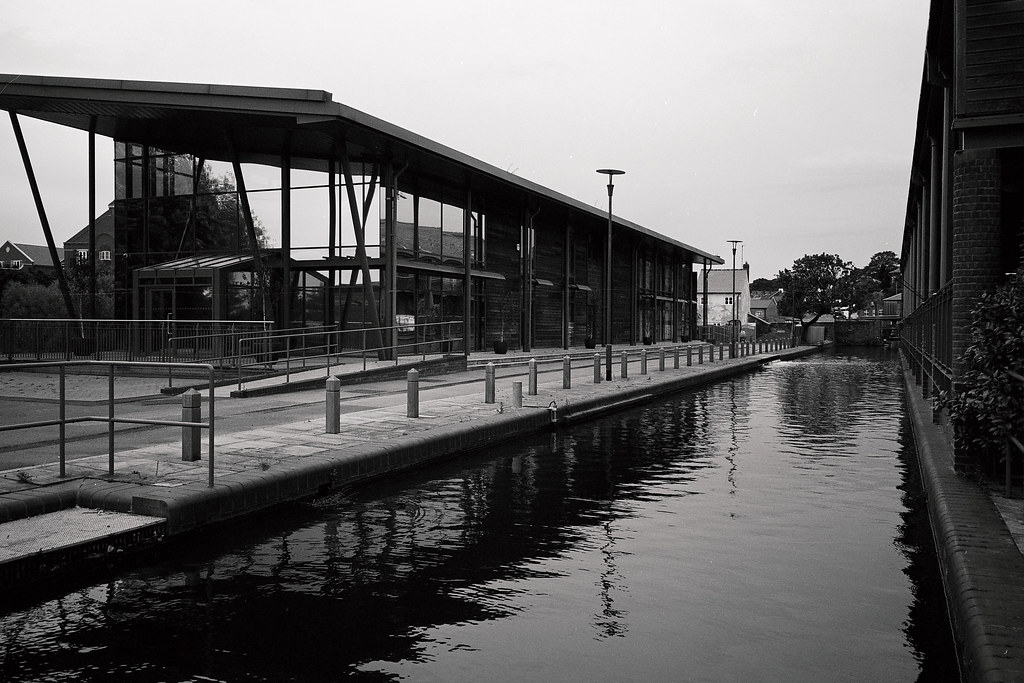
Despite this near perfection in most areas, the lens still manages to exude character, a character that is largely dominated by what can best be described as fairly heavy light fall off. This vignetting is reduced slightly by stopping down but it’s basically always a feature. For my personal tastes though, this is far from being an issue, without it there may be a danger a lens like this could seem clinical. With it, photos have an identifiable look to them, they draw you in, and a very hard not to be instantly impressed by.
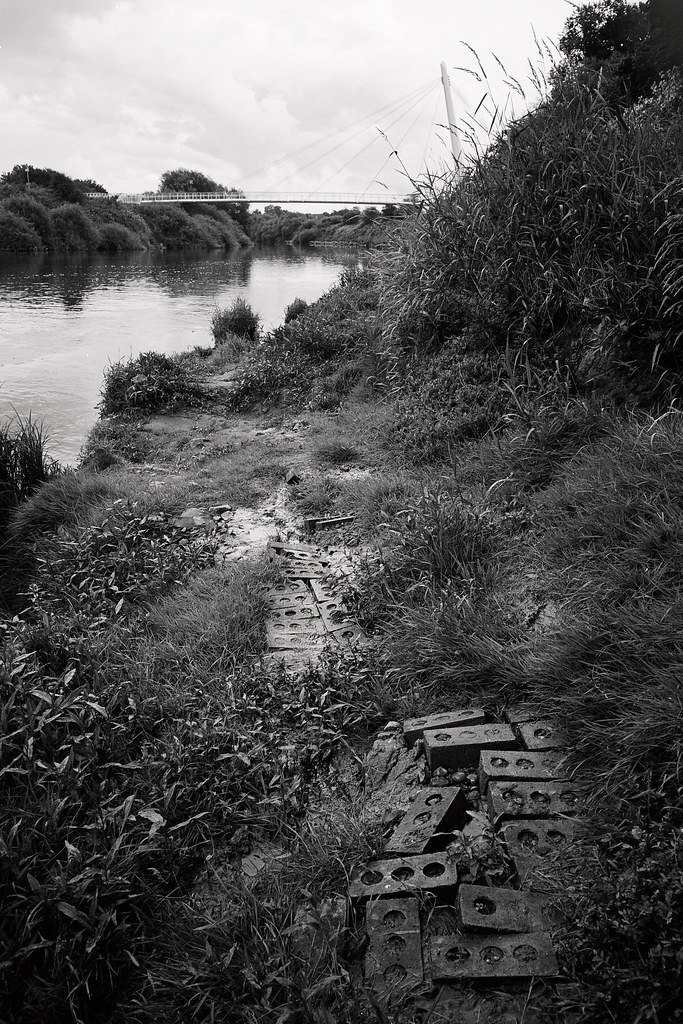
Of course though, there is the limitation of it only being an f/3.5 lens. This being a factor that is hard to escape in those few situations I find myself in where the camera is giving me a slightly slower shutter speed than I’d like. It’s hard not to think “If only it were a 2.8 lens” when that happens. But then I have to remind myself that when shooting the Ricoh GR1v I sometimes have the same “If only it were a faster lens” feeling. And more often than not – in those situations – I revert to an RF with something faster anyway… Or just switch on the flash.
And then there is the aperture priority limitation. The fact that this camera can only ever be shot in aperture priority mode makes for a little getting used to coming from basically all other AF compact cameras. Everything about using a camera this small lulls me into the idea that it is going to make decisions for me, especially since I have shot so many similar cameras that do just that. But this camera doesn’t; going from indoors to outdoors – almost every time I use it – I am surprised when looking through that finder and it gives me a flashing “500”. Of course just like when using the M7, I stop the aperture down and carry on shooting. There is no extra trouble in shooting aperture priority really, I just need to better train myself to remember that’s what I am doing with this camera. The limited amount of stops isn’t really an issue in use either, if anything it’s actually helpful. With the camera to the eye, having only four possible options for aperture means setting it by feel is actually pretty easy.
Minolta TC-1 vs Ricoh GR1v
I love the Minolta lens – it’s a bit like a Ricoh GR1v lens on steroids – and I like that, but I’m sure others would prefer something less characterful. The Minolta lens brings drama with its vignetting, and doesn’t seem to suffer from flare, the GR1 lens suffers slightly more with flare, but doesn’t suffer the same levels of light fall-off. Both are remarkable in terms of resolution, with the Minolta having a touch more contrast to my eye. The GR1 lens also brings an extra 2/3rds of a stop of light gathering power. The GR1 handles slightly better, but doesn’t feel as nice a thing. The GR1 feels more like a point & shoot, the TC-1 feels like it requires more thought to use – and comes with the extra benefits of a spot meter to allow that extra thought. Though with this extra benefit comes an autofocus that doesn’t quite feel as reliable. Yes you can see the distance you have focused – which is lacking in the GR1 – but where the TC-1 sometimes misses, the GR1 so rarely misses I don’t think distance indicator feature is even needed on it. The size difference is negligible, and ultimately, caveat emptor, it seems both are now prone to failure.
Overall I would say the Ricoh is the more obvious choice for those looking for a more point & shoot experience, those looking to shoot quickly with little thought to much more than composition and know that they are unlikely to be let down by the camera. With its 3 point AF it’s also better suited to those who want to take photos of their friends in social situations. The TC-1 is better placed in the hands of someone who finds departing from manual controls harder, someone who likes to think a bit harder about each photo and can afford – through a more stationary choice of subject – the camera missing the desired point of focus the fairly rare time it decides to.
Perfect camera (for me) status?
When I set out on this path I was looking for something that would replace the GR1v in my little kit bag. In many respects I have found just that. For most of what I like to shoot it is absolutely ideal. For both urban and non-urban landscapes it brings a drama to the results that I find it hard not to be suckered in by. Yet, “better” photos is not the whole of what I was looking for. I’ve got something here that is closer in function to the Leica M7 than I bargained for, which since I love the M7, is hard to argue against. But I was looking for a point & shoot to replace a point & shoot, and that isn’t what I’ve got. But that is – by no means – to say that I’m disappointed in my purchase. For my aforementioned purposes, the GR1v possibly remains a slightly more ideal counterpart to the M7, yet overall I still think the Minolta is a better camera that will bring me more pleasure in more shooting situations and give me photos that I would prefer to those of the GR1… get your head around that one!
So to conclude…
If there is one thing I was right about in my assumptions of this little camera, it’s that it is an eccentric little thing; or at very least feels like it was designed by one. It exudes quality, and feels like it was designed to do so. I’m not sure if its original retail price, but I’ve read it was high – luxury high – and that doesn’t surprise me. Yet like my M7 – another camera that feels like a luxury object to me – it doesn’t patronise, or feel like it’s designed as a toy for rich people. Its function is clearly designed for someone who knows what they are doing and likes to shoot in a certain way. Yes, some features like the slightly mind boggling flash, the Automatic Aperture Compensation System, and borderline pointless manual only, four setting, circular stop aperture seem odd. But these oddities aren’t obstructive – as strange as they may be, they have little or no negative outcome on photo taking experience. And in the case of the manual aperture, it actually gives a greater feeling of being connected to the photo taking process. In fact combined with the spot meter, it’s possible to feel almost entirely in control of the camera – a rare feat for any AF compact, never mind one so small.
In short, It maybe not the perfectly ideal camera for a point & shoot happy snapper, but for someone looking for a stunning 28mm lens, on a camera they want to feel in command of, this camera is a real winner! And the fact it achieves this, and manages to be one of the smallest 35mm cameras ever made… Well, it’s nothing shot of astounding really!
Some more photos I’ve taken with this camera can be found here on my flickr
Cheers for reading
Hamish
Share this post:
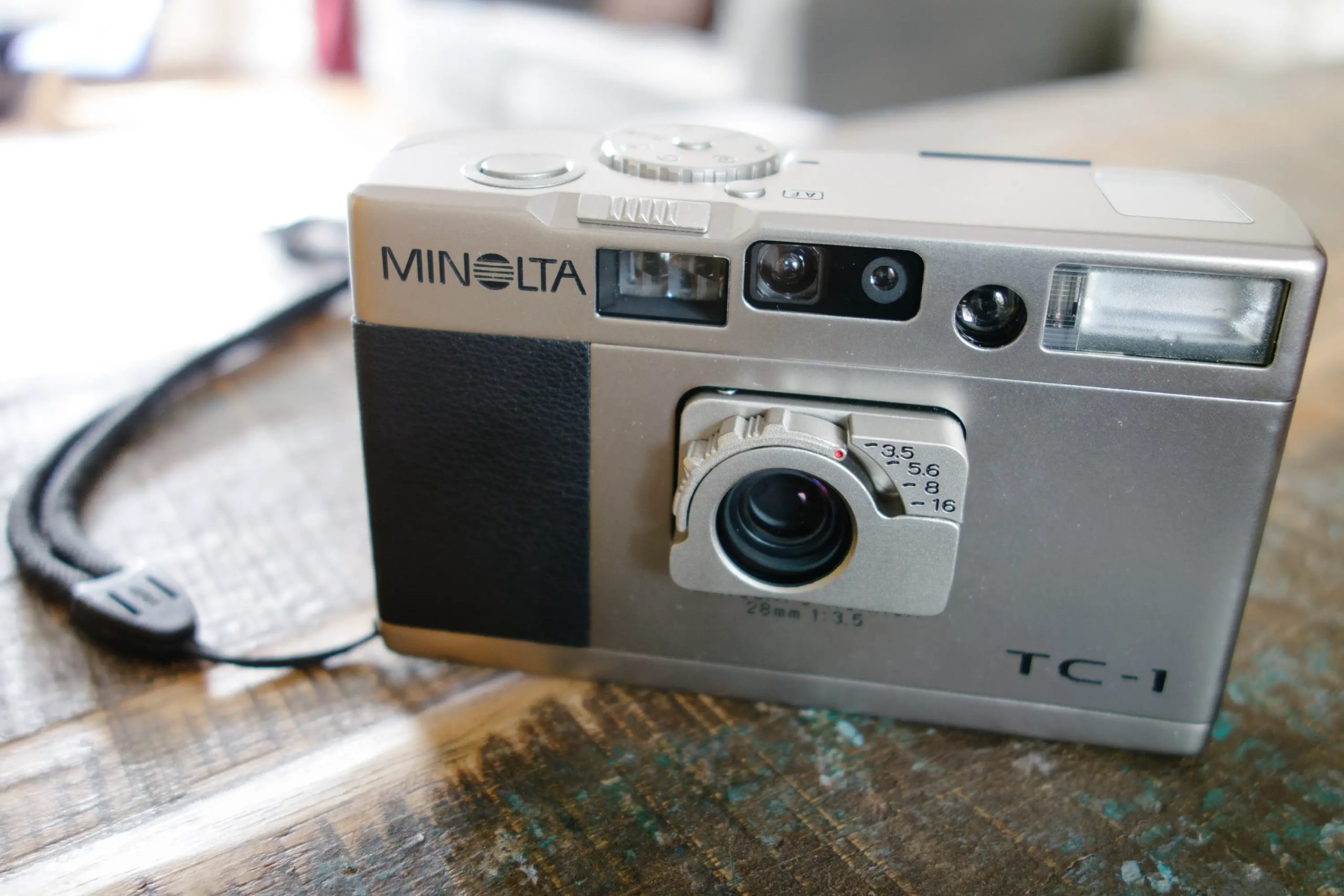

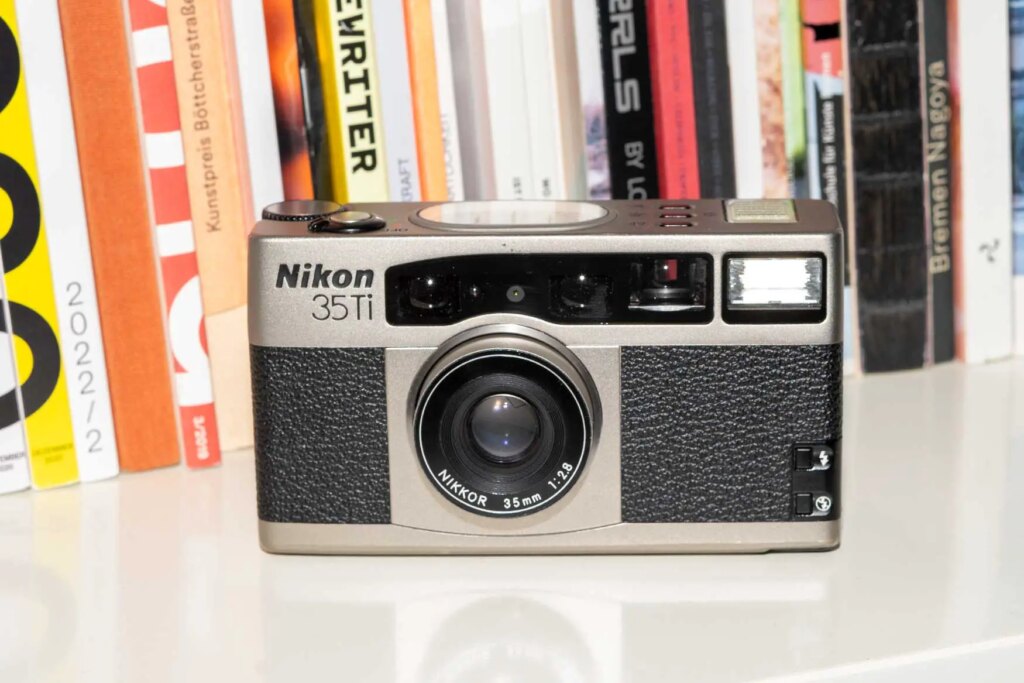
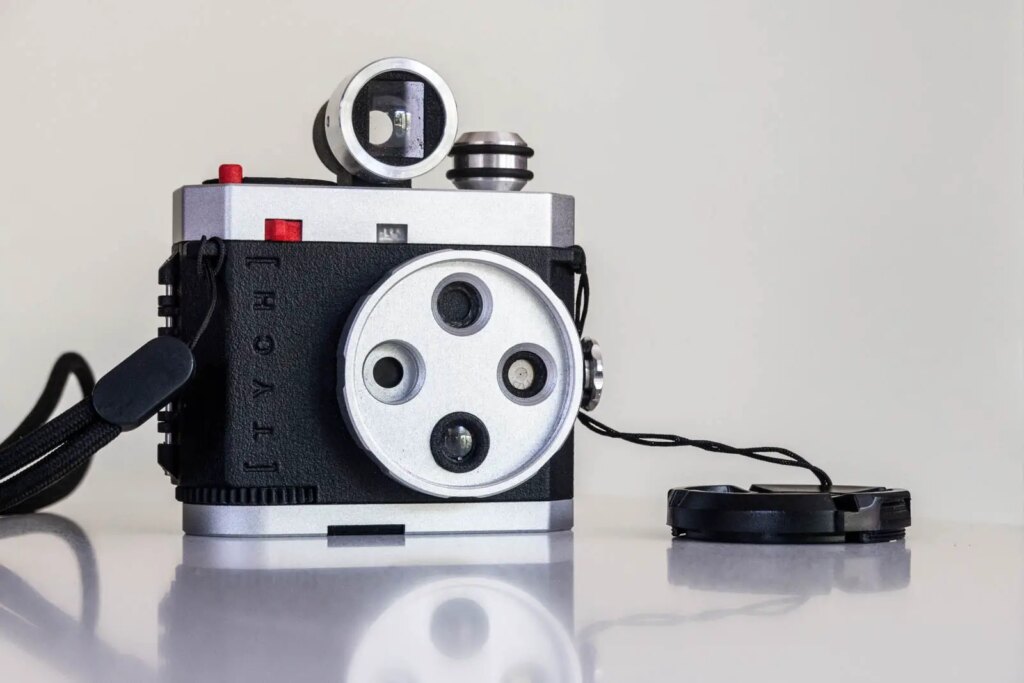
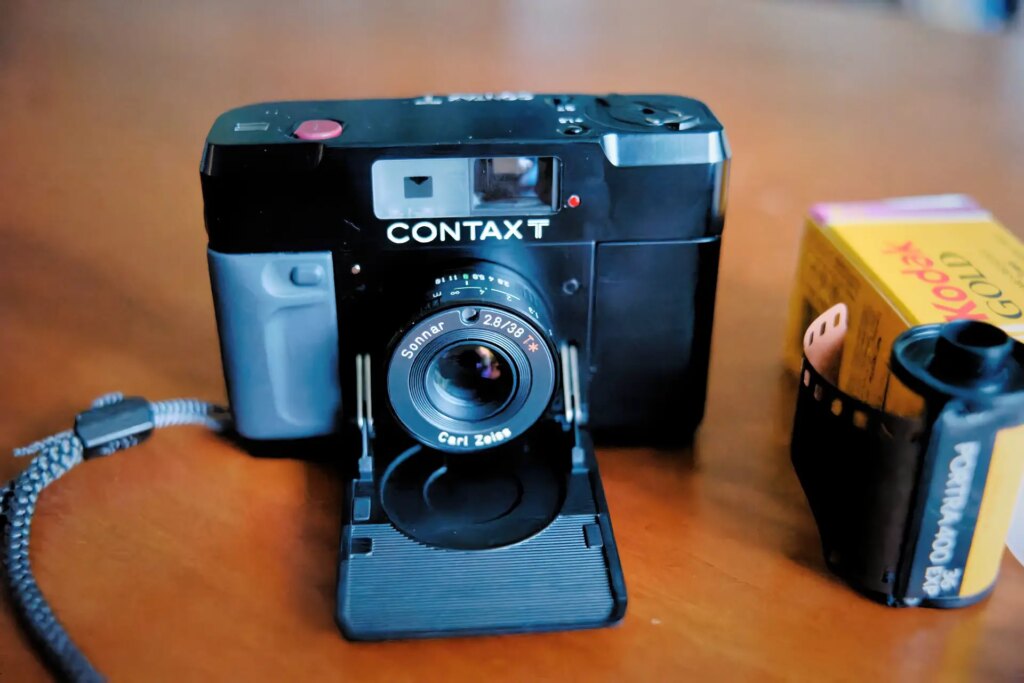




Comments
Gary on Minolta TC-1 Review – An Eccentric Beauty
Comment posted: 28/09/2014
I agree the focus and the film wind is noisy.
And absolutely minimal shutter lag: I like how the lens racks out while focussing and prior to shutter release. I wish that the lens could be set to stay put when using manual focus -- it would be quieter and even faster.
Comment posted: 28/09/2014
Comment posted: 28/09/2014
Gary on Minolta TC-1 Review – An Eccentric Beauty
Comment posted: 29/09/2014
And as for the plastic surround of the viewfinder, it prevents scratching glasses.
Nice review!
The MSRP was over $2000. Considering they cost less than a GR1V now on eBay -- well!
Heres a difficult to google link to a beautiful scan of the brochure
http://www3.xitek.com/catalog/minolta/tc-1/m-tc1.htm
Comment posted: 29/09/2014
Francois on Minolta TC-1 Review – An Eccentric Beauty
Comment posted: 07/10/2014
Anyhow, good details and contrast in your pictures, we should start an exchange group to trade cameras, would be less an hassle than buying & selling on E...y.
Ned on Minolta TC-1 Review – An Eccentric Beauty
Comment posted: 03/02/2015
Hope you don't mind me bending your ear for a bit of objective opinion.
I posted on one of your other reviews that I have borrowed a Minolta TC-1 and shot a roll of colour film with it.
I also shot the same type of film through my Leica CL / 40mm Summicron.
Much as I prefer the feel & handling of the wee Leica, the results from the TC-1 blew it out of the water!
I hadn't expected that.
With your knowledge of the TC-1 and Leica glass, does that make sense?
The CL and lens are in good nick and the rangefinder is accurate, so the CL isn't off.
Cheers
Comment posted: 03/02/2015
Comment posted: 03/02/2015
lux on Minolta TC-1 Review – An Eccentric Beauty
Comment posted: 04/05/2015
The shiny but scratch-prone titanium shell, the cool but delicate-feeling mechanisms, the smart but not very intuitive-to-use push-and-turn interface, the very informative but smallish real-image viewfinder (no frame lines), plus the price tag. Words still comes from time to time that someone had their TC-1 repaired in Japan, but the cost is worth another copy with box if you source from Yahoo Auction.
In the end I ended up with two beater GR1vs (in case one fails) and, after some effort, a G-Rokkor. Really love the way the 5/5 lens draws. But the camera itself I must refrain from - although I always insist that everyone should have a TC-1 at one point during their P&S journeys.
Comment posted: 04/05/2015
Joe Bonfatto on Minolta TC-1 Review – An Eccentric Beauty
Comment posted: 19/11/2015
I bought a TC-1 a few months ago. After putting a few rolls through it, the led display started to
flash as alluded to in the owners manual. Camera is inoperative until the battery is remove and it resets.
Of course this happens after every shutter release.
I have been trying to find a repair service, and unfortunately the only one left is ay Minolta in Japan.
Since you had yours repaired there could you give me an address or contact information?
This would be greatly appreciated. I love using the camera.
Regards,
Joe B.
Comment posted: 19/11/2015
Turen on Minolta TC-1 Review – An Eccentric Beauty
Comment posted: 13/01/2016
Comment posted: 13/01/2016
Pick (a) Pocket: The Minolta TC-1 :: ULTRAsomething photography on Minolta TC-1 Review – An Eccentric Beauty
Comment posted: 01/04/2016
jojonas on Minolta TC-1 Review – An Eccentric Beauty
Comment posted: 23/05/2016
Comment posted: 23/05/2016
Kodachromeguy on Minolta TC-1 Review – An Eccentric Beauty
Comment posted: 12/06/2016
Comment posted: 12/06/2016
5 Frames with a Ricoh GR1s - by Steven Bleistein - 35mmc on Minolta TC-1 Review – An Eccentric Beauty
Comment posted: 12/09/2018
Randall Stewart on Minolta TC-1 Review – An Eccentric Beauty
Comment posted: 25/09/2018
5 frames with the Minolta TC1 - By Isa Maidan - 35mmc on Minolta TC-1 Review – An Eccentric Beauty
Comment posted: 29/12/2018
The problem with the premium film compact bubble - Kosmo Foto on Minolta TC-1 Review – An Eccentric Beauty
Comment posted: 02/04/2019
The Minolta G-Rokkor 28mm f/3.5 - Another Gem I'm Parting With - 35mmc on Minolta TC-1 Review – An Eccentric Beauty
Comment posted: 10/02/2020
Jack on Minolta TC-1 Review – An Eccentric Beauty
Comment posted: 19/04/2021
I have a tc-1 and can’t work out how to get the flash mode to deactivate. It has done what you describe in the article and remains set even after switching off and on.
Do you have any tips on how to get the flash mode to turn off?
Comment posted: 19/04/2021
Rocco Vincent on Minolta TC-1 Review – An Eccentric Beauty
Comment posted: 11/05/2021
Comment posted: 11/05/2021
Comment posted: 11/05/2021
See on Minolta TC-1 Review – An Eccentric Beauty
Comment posted: 26/03/2022